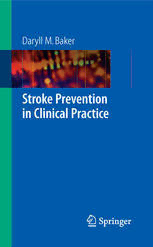
Stroke Prevention in Clinical Practice PDF
Preview Stroke Prevention in Clinical Practice
Stroke Prevention in Clinical Practice Stroke Prevention in Clinical Practice Daryll M. Baker DaryllM.Baker,PhD,FRCS ConsultantVascularSurgeon RoyalFreeHospital London,UK BritishLibraryCataloguinginPublicationData Baker,DaryllM. Stroke prevention in clinical practice 1. Cerebrovascular disease – Prevention 2. Cerebrovascular disease – Diagnosis 3. Cerebrovascular disease–Treatment4.Transientischemicattack–Diagnosis I.Title 616.8(cid:2)105 LibraryofCongressControlNumber:2007926595 ISBN978-1-85233-964-7 e-ISBN978-1-84628-728-2 Printedonacid-freepaper ©Springer-VerlagLondonLimited2008 Apartfromanyfairdealingforthepurposesofresearchorprivatestudy, or criticism or review, as permitted under the Copyright, Designs and Patents Act 1988, this publication may only be reproduced, stored or transmitted,inanyformorbyanymeans,withthepriorpermissionin writingofthepublishers,orinthecaseofreprographicreproductionin accordancewiththetermsoflicencesissuedbytheCopyrightLicensing Agency. Enquiries concerning reproduction outside those terms should besenttothepublishers. The use of registered names, trademarks, etc. in this publication does notimply,evenintheabsenceofaspecificstatement,thatsuchnames areexemptfromtherelevantlawsandregulationsandthereforefreefor generaluse. Product liability: The publisher can give no guarantee for information aboutdrugdosageandapplicationthereofcontainedinthisbook.Inevery individualcasetherespectiveusermustcheckitsaccuracybyconsulting otherpharmaceuticalliterature. 987654321 SpringerScience+BusinessMedia springer.com Preface Stroke is the third most common cause of death in the world. Furthermore,forthosewhosurvive,strokeisthemostcommon cause of severe disability, such that after a year, 25% are still dependent on someone else for everyday activities, and within 5 years,athirdofthesewillhavesufferedasecondstroke. Clearly, every effort to reduce the incidence and severity of strokeneedstobetaken. This handbook considers the different ways of reducing the risk of ischaemic stroke. A summary of the significance of each riskfactorisfollowedbyanoutlineonhowtomakethediagnosis both on the basis of clinical features and with investigations. How to modify the risk factor is then considered along with the associated risks of intervention and evidence for the recommen- dation.Relevantreferencesaregivenifmoredetailedinformation isrequired. Contents Preface................................................. v I. Introduction 1. The Significance of Stroke......................... 3 2. Identifying Patients at Risk of Ischemic Stroke.... 7 3. Investigating Patients at Risk of Stroke............ 15 II. Reducing the Risk of Stroke by Reducing Embolic Events 4. Antiplatelet Therapy................................ 19 5. Reducing Cardioembolic Events................... 25 The Management of Atrial Fibrillation................ 27 Managing Cardiac Valve Lesions.......................... 32 Acute Myocardial Infarction................................. 39 Mural Disease......................................................... 41 6. Reducing Cervical Vessel Embolic Events......... 47 III. Reducing the Risk of Stroke by Modifying Atherosclerotic Risk Factors 7. Managing Hypertension............................ 61 8. Managing Diabetes................................. 65 viii CONTENTS 9. Managing Hyperlipidemia.......................... 69 10. Reducing the Risk of Stroke by Modifying Life Style........................................... 73 Smoking Cessation................................................. 73 Obesity.................................................................... 77 Exercise and Fitness.............................................. 81 Diet Modification................................................... 85 11. Identifying Other Atherosclerotic Diseases......... 89 12. Managing Lacunar Infarcts........................ 93 IV. Reducing the Risk of Stroke by Reducing Procoagulant (Thrombotic) Risk Factors 13. Managing Procoagulant Thrombotic States........ 97 Managing Thrombophilia (Disturbances in Coagulation/Anticoagulation Cascade)........ 97 Managing Sickle Cell Disease................................ 99 Managing Myeloproliferative Disorders...............101 V. ReducingtheRiskofStrokefromOtherCauses 14. Managing Central Nervous System Vasculitis......107 15. Managing Stroke in Human Immunodeficiency Virus–Infected Patients........111 16. Thyroid Diseases and Stroke.......................113 VI. Prevention of Other Cardiovascular Events in Cerebrovascular Patients 17. Management of Silent Myocardial Ischemia in Stroke Patients.................................. 117 Index...................................................121 Part I Introduction Chapter 1 The Significance of Stroke Strokeisacommondiseasewithahighmorbidityandmortality.All effortstoreduceitsoccurrenceneedtobeundertaken. DEFINITION Stroke is a clinical syndrome associated with the sudden loss of focal brain function for more than 24 hours. It is caused by an interruption in the blood supply to the affected brain area (ischemic stroke) or by a spontaneous hemorrhage into or over thebrain(ahemorrhagicstroke). A transient ischemic attack (TIA) is a syndrome associated withthesuddenlossoffocalbrainormonocularfunctionlasting lessthan24hours,andusuallyonlyafewminutes. Amaurosis fugax is a TIA of the eye and is sudden transient monocularblindness. INCIDENCE Theincidenceoffirststrokeis200per100,000peryear(0.2%of the population). The incidence of cerebral TIA is 50 per 100,000 peryear.Theincidenceofstrokeisinfluencedbythefollowing: 1. Age: the incidence rises rapidly with increased age, with one quarteroccurringbeforetheageof65yearsandonehalfbefore theageof75years. 2. Race:theincidenceofallstrokesishigherinblacks.Thismaybe duetoahigherprevalenceofriskfactorssuchashypertension, diabetes,obesityandsicklecelltraitinblacksthaninwhites. 3. Geographical variations: there is a higher incidence of stroke inEasternEuropeandChinathaninFrance. Sexisnotafactor,asstrokehasanequaldistribution. 4 STROKEPREVENTIONINCLINICALPRACTICE PREVALENCE Theprevalencedependsontheincidenceandsurvival.Thepreva- lenceofstrokeis5to12per1000population,butishigherwith increasedage,andinmalesandblackpopulations. MORBIDITY DisabilityfromStroke StrokeisthemostimportantcauseofseveredisabilityinEngland andWales. With good rehabilitation, neurological function often begins to improve within a few days of the stroke and continues to improve, especially within the first 3 months. After this period, improvementisataslowerrate,andat1to2yearsonlyminimal improvementisachieved. A year after a stroke, 25% of patients are dependent on someone else for everyday activities such as dressing, washing, andmobilizing,but50%doliveindependently.Onanindividual basis this depends not only on the magnitude of the stroke and degree of recovery, but also on the premorbid disabilities and socialsupportavailable. RiskofRecurrentStroke Despite undertaking all stroke preventative measures the risk of arecurrentstrokeremains.Thisisaround3%inthefirstmonth, and15%withinthefirstyear,butfallsto5%peryearthereafter, sothatat5years30%willhavesufferedasecondstroke. RiskofCardiovascularDisease Afterastroke,5%to10%ofpatientssufferamyocardialinfarct eachyear. MORTALITY Stroke is the third commonest cause of death throughout the world,aftercoronaryheartdiseaseandallcancers.Therearefive million deaths a year from stroke, 75% of which occur in the developingworld. Twenty-five percent of all stroke patients are dead within a year of their first stroke, which accounts for 12% of deaths, an incidence of 60 per 100,000 population per year in England and Wales.
